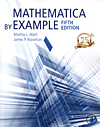- About MAA
- Membership
- MAA Publications
- Periodicals
- Blogs
- MAA Book Series
- MAA Press (an imprint of the AMS)
- MAA Notes
- MAA Reviews
- Mathematical Communication
- Information for Libraries
- Author Resources
- Advertise with MAA
- Meetings
- Competitions
- Programs
- Communities
- MAA Sections
- SIGMAA
- MAA Connect
- Students
- MAA Awards
- Awards Booklets
- Writing Awards
- Teaching Awards
- Service Awards
- Research Awards
- Lecture Awards
- Putnam Competition Individual and Team Winners
- D. E. Shaw Group AMC 8 Awards & Certificates
- Maryam Mirzakhani AMC 10 A Awards & Certificates
- Two Sigma AMC 10 B Awards & Certificates
- Jane Street AMC 12 A Awards & Certificates
- Akamai AMC 12 B Awards & Certificates
- High School Teachers
- News
You are here
Mathematica by Example

Publisher:
Academic Press
Publication Date:
2017
Number of Pages:
564
Format:
Paperback
Edition:
5
Price:
99.95
ISBN:
9780128124819
Category:
Textbook
[Reviewed by , on ]
Allen Stenger
10/4/2017
I would call this a workmanlike book. There’s nothing startling in it, and its goals are modest, but it does a good job of reaching its goals.
Mathematica probably has thousands of features, so the challenge in designing an introductory book is deciding which ones to cover. The present book closely follows undergraduate engineering and math curricula, so it has an emphasis on calculus, linear algebra, and differential equations. It presents Mathematica as an oracle: it gives many examples of problems that would likely be assigned in undergraduate courses, and shows how to ask Mathematica to produce the final answer. The book does cover some of the theory of hand solutions. For example, on p. 203 we look at how to sum a telescoping series by hand, and then have Mathematica solve the problem directly. On p. 446 we look at how to solve a first-order linear differential equation by integrating factors, and again have Mathematica solve the problem directly.
The book takes a primarily pure-math approach, where we are already given the model or the equation or the formula to solve; it makes little reference to applications. The book deals almost exclusively in analytic solutions, where it uses the symbolic algebra features of Mathematica. Issues of numerical accuracy and machine precision seem never to come up. Even the simplest numerical methods, such as the trapezoidal rule for integration, are not mentioned. I think the only occasion when numerics come up is when Mathematica is unable to produce an analytic answer, such as the difficult integral on p. 174, where we are taught that we can salvage something by asking Mathematica for a numerical approximation.
The book is primarily a reference rather than something you would work through systematically, and it has an extensive table of contents and index to make it easy to look up things. The publisher advertises that there is an ancillary web site where the example codes can be downloaded, but I was not able to locate it. The publisher also says it covers Mathematica version 10.4, but actually it covers version 11.
Mathematica for undergraduates seems to be a specialized market (I image most undergrads use MATLAB), and I don’t know any other book that competes directly with this one. Another book with somewhat similar coverage is Torrence & Torrence’s Student’s Introduction to Mathematica, although this hasn’t been updated since 2009. A beautiful book for some enrichment work is Stan Wagon’s Mathematica in Action; this is nearly as old, going back to 2010, but it’s more about using Mathematica for exploration than it is about the mechanics.
Allen Stenger is a math hobbyist and retired software developer. He is an editor of the Missouri Journal of Mathematical Sciences. His personal web page is allenstenger.com. His mathematical interests are number theory and classical analysis.
1. Getting Started
2. Numbers, Expressions and Functions
3. Calculus
4. Introduction to Lists and Tables
5. Nested Lists: Matrices and Vectors
6. Applications Related to Ordinary and Partial Differential Equations
- Log in to post comments




